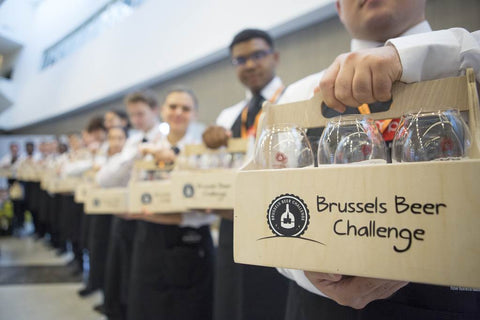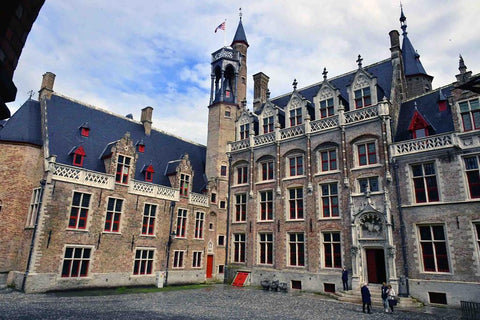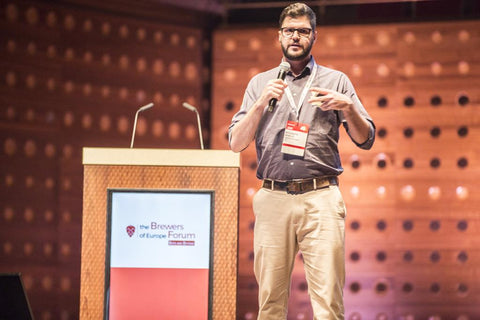- No products in the cart.
Westmalle… where Trappists say “Cheese”
WESTMALLE - Westmalle Dubbel and Tripel are iconic Trappist beers. The popularity of the beers makes people almost forget that these monks also produce a tasty cheese.
Westmalle Abbey is built on moorland which is quite bleak and not very productive from an agricultural point of view. However, throughout the years and by sheer virtue of hard work, the monks established fields and meadows that now cover around 300 hectares.
This has enabled two hundred dairy cows to be grazed which are mainly from two breeds: Groningse Blaarkop and Brown Swiss. These cattle varieties are not generally known for their high milk production; however, the milk they do produce on the monks’ lush meadows is of a very high quality.
The cows are milked twice a day. They will step into the auto-tandem – a type of carousel – that has 28 milking positions. These pampered cows lead a stress-free life and are treated with care, producing milk destined for the cheese workshop and some also goes to a local dairy.
“We have opted for sustainable agriculture and this includes the rearing of our cattle,” Brother Francis tells us. “The cows graze in our own meadows, they are fed from own fields and from the milk they produce, we make our own Trappist cheese. The term ‘short chain’ can be taken quite literally here.”

The Blessed Peace
I am allowed a peek within the abbey walls where I am shown a modern cheese dairy unit (built in 2011) and the places where the cows are housed. Once more, I am overwhelmed by the atmosphere of peace and quiet that prevails here - at no point during my visit do I have the feeling of visiting a business.
“The former cheese dairy (1860) was located right next to the brewery,” Brother Francis explains. “Cheese has always been important to us."
"Ever since 1834, when the Abbey was founded, we have been producing beer, cheese and bread. Just take a look at the shape of the cheese: it is perfectly attuned to the way we shape our bread."
"This is how the cheese forms a natural complement to our bread and makes for the ideal sandwich filling."
The Trappist cheese from Westmalle was a well-kept secret for many years; only the locals knew that you could buy it from the abbey gate. These days, the cheese is more heavily promoted and can be often found in specialised cheese shops.
Today we are tasting this cheese with a degustation glass of Dubbel and Tripel in Café Trappisten, located just across the road. Westmalle cheese is low in salt (1%), is pure, healthy and nourishing as it does not contain any preservatives, colouring agents or additional flavours.
Its aromas and tastes are determined by the way the animals are fed and also depend on the seasons. Just like they do with their beer, the monks are striving for harmony, balance and complexity.
I find the slightly sour taste of this cheese quite exceptional. “You’ll not get bored with this cheese,” Brother Francis tells me. “And I should know: I eat it every day!”
This cheese forms a great pairing with the robust beers produced by the Trappists. “On ageing, this cheese will developed even more intense tastes,” the monk assures us.

Take Your Time
The day starts early in the cheese dairy. The cheese tub is filled with the previous day’s milk, heated to a temperature between 40°C and 72°C. The cheese master is now heating up the milk to a temperature of 30°C, stirring all the while.
“You need ten litres of milk to produce one kilo of cheese,” he explains. Rennet is added to create a gelatinous mass: these are the curds. The cheese master allows the curds to firm up before cutting it into shapes.
The liquid whey is now separated from the curd – the whey is used as cattle feed – whilst the curds are rinsed in warm water.
To produce a hard cheese, the Westmalle Trappist for example, the curds will be transferred to a mould before being pressed to ensure the last traces of whey drain away. This cheese will pressed three times, resulting in a homogenous cheese where all the solid particles stick together.
Now, the cheese will be bathed in brine for ten hours to allow it to develop its zesty taste. And finally, it will mature for anything between eight weeks and 12 months in a dedicated maturation chamber at a temperature between 13 and 15°C, at a humidity of 85 to 95%.
During this time, the cheese forms a crust that protects it from mould and the cheese makers will turn each cheese by hand every day.
After all that time, loving care, skill and patience … the delicious cheese is ready to enjoy. Have you put your Westmalle Trappist in to chill?
More info on Westmalle
Brouwerij Westmalle
Abdij Westmalle Antwerpsesteenweg 496
B-2390 Malle
Belgium
Website: www.trappistwestmalle.be
Facebook: Westmalle






